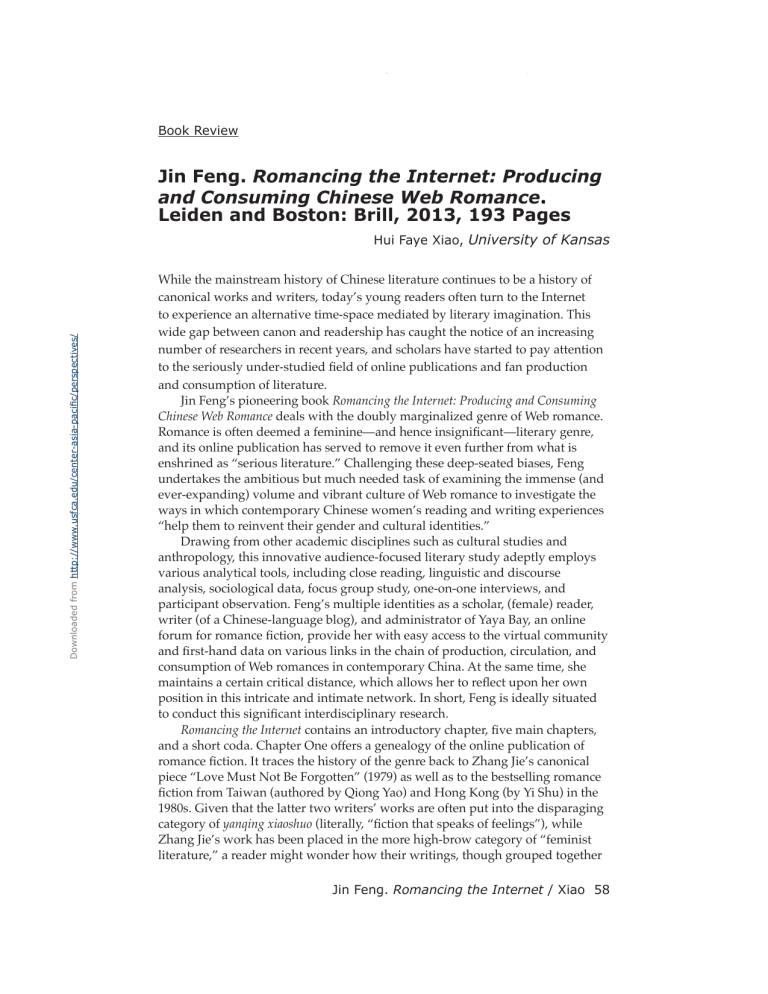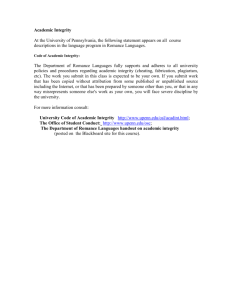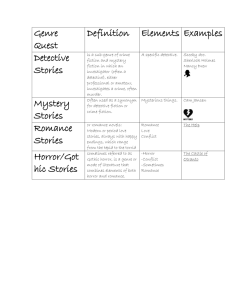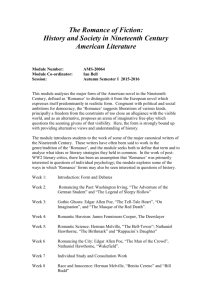
Asia Pacific Perspectives ∙ Spring/Summer 2014 Book Review Jin Feng. Romancing the Internet: Producing and Consuming Chinese Web Romance. Leiden and Boston: Brill, 2013, 193 Pages Downloaded from http://www.usfca.edu/center-asia-pacific/perspectives/ Hui Faye Xiao, University of Kansas While the mainstream history of Chinese literature continues to be a history of canonical works and writers, today’s young readers often turn to the Internet to experience an alternative time-space mediated by literary imagination. This wide gap between canon and readership has caught the notice of an increasing number of researchers in recent years, and scholars have started to pay attention to the seriously under-studied field of online publications and fan production and consumption of literature. Jin Feng’s pioneering book Romancing the Internet: Producing and Consuming Chinese Web Romance deals with the doubly marginalized genre of Web romance. Romance is often deemed a feminine—and hence insignificant—literary genre, and its online publication has served to remove it even further from what is enshrined as “serious literature.” Challenging these deep-seated biases, Feng undertakes the ambitious but much needed task of examining the immense (and ever-expanding) volume and vibrant culture of Web romance to investigate the ways in which contemporary Chinese women’s reading and writing experiences “help them to reinvent their gender and cultural identities.” Drawing from other academic disciplines such as cultural studies and anthropology, this innovative audience-focused literary study adeptly employs various analytical tools, including close reading, linguistic and discourse analysis, sociological data, focus group study, one-on-one interviews, and participant observation. Feng’s multiple identities as a scholar, (female) reader, writer (of a Chinese-language blog), and administrator of Yaya Bay, an online forum for romance fiction, provide her with easy access to the virtual community and first-hand data on various links in the chain of production, circulation, and consumption of Web romances in contemporary China. At the same time, she maintains a certain critical distance, which allows her to reflect upon her own position in this intricate and intimate network. In short, Feng is ideally situated to conduct this significant interdisciplinary research. Romancing the Internet contains an introductory chapter, five main chapters, and a short coda. Chapter One offers a genealogy of the online publication of romance fiction. It traces the history of the genre back to Zhang Jie’s canonical piece “Love Must Not Be Forgotten” (1979) as well as to the bestselling romance fiction from Taiwan (authored by Qiong Yao) and Hong Kong (by Yi Shu) in the 1980s. Given that the latter two writers’ works are often put into the disparaging category of yanqing xiaoshuo (literally, “fiction that speaks of feelings”), while Zhang Jie’s work has been placed in the more high-brow category of “feminist literature,” a reader might wonder how their writings, though grouped together Jin Feng. Romancing the Internet / Xiao 58 Downloaded from http://www.usfca.edu/center-asia-pacific/perspectives/ Asia Pacific Perspectives ∙ Spring/Summer 2014 under the same English umbrella term of romance, engage differently with the literary discourse of qing (feelings, passion, sentiment), which originated in imperial China. Feng’s argument would be strengthened had she provided a more careful analysis of the reasons behind such hierarchical classification—the most likely culprits being the deep-rooted biases against commercial bestsellers and “excessive” sentimentality in mainstream literary historiography, as well as the different socio-political conditions under which these works have been published, distributed, and received, and in particular the role played by the market economy. Feng then provides a comprehensive account of the essential political and economic issues around Web publishing, including state regulations and censorship of the Internet, the increasing commercialization of Web publishing, the demographic make-up of Chinese-speaking netizens, and the narratological characteristics of Chinese-language Web romance. In this rich study of online romance writing and reading, Feng mainly investigates two “habitats”: Yaya Bay, “a U.S.-based Chinese-language website that circulates novels, especially popular romances, that were originally published on other websites”; and Jinjiang Literature City (jjwxc.net), arguably “the largest Chinese-language women’s literature website in the world.” These two websites not only vary in scale and location, but also exemplify two kinds of online fiction website: Yaya Bay is a smaller and more user-friendly virtual community for Web fiction writers and readers, while Jinjiang is famous for its profit-driven expansion and commercial ambition. Chapters Two to Five examine the different subgenres that add diversity of narrative devices and conventions to the fast-growing repertoire of Webpublished romance fiction: danmei (tanbi in Japanese, literally “addicted to beauty,” referring to “male-male homoerotic fiction”), nüzun (“matriarchal fiction that features women’s dominance in a matriarchal society”), tongren (fan fiction or fanfic), and chuanyue (time-travel). While drawing inspirations from Qiong Yao-style romance narratives, today’s Web fiction writers, Feng argues, modify Qiong Yao-style character types and ideals of feminine virtues, and take advantage of more possibilities for discursive forms, audio-visual expressions, “textual poaching,” and writer-reader interactions in the current multimedia environment. The writing and reading of various subgenres of Web fiction bend gender norms, explore alternative cultural imaginations and practices of masculinity and femininity, and generate a group of what Feng refers to as “androgynous readers” who tend to hold a more liberal attitude towards homosexuality. One prominent feature in these Web romances is an inward-turning trend: the fictional narratives focus, almost exclusively, on domestic and psychological interiors. As has been noted by many scholars including myself, this is also a dominant trend in post-Mao Chinese women’s literature and film. This common quality, shared by online and offline writings, invites an important question: How shall we situate our reading of the Web romance in the larger context of contemporary Chinese feminist writings, theories, and practices? Feng’s probing study not only expands the boundaries of mainstream scholarship on Chinese cyber culture, which has tended to focus more on “issues of state censorship and civil liberties,” it also challenges the conventional wisdom Jin Feng. Romancing the Internet / Xiao 59 Downloaded from http://www.usfca.edu/center-asia-pacific/perspectives/ Asia Pacific Perspectives ∙ Spring/Summer 2014 concerning what should be regarded as “good literature.” The chapter about the U.S.-based Yaya Bay also ventures into the study of Sinophone literature and diaspora identities. However, it is a bit surprising to find that some of the most popular Web romances, such as Suspense at Every Step, Palace Locked the Heart of Jade, and The Tale of Zhen Huan, are only mentioned in passing. A close reading of these texts, which have achieved cult status among Web romance fans, and an analysis of the political economy of their production, circulation, and reception will shed new light on our understanding of the genre and its fan culture. Furthermore, since all these canonical works have been republished as books on paper and have been adapted into television megahits, perhaps more could be said on the intricate relationships between cyber culture (often deemed xiaozhong, meaning non-mainstream or unofficial) and traditional print culture (usually considered more official or high-brow in comparison). The relationship between new media (particularly the Internet) and traditional mass media (such as television networks) also merits discussion. Overall, Jin Feng’s Romancing the Internet: Producing and Consuming Chinese Web Romance is a timely and welcome contribution to a multitude of disciplines, including literary studies, Internet studies, cultural studies, fandom studies, and gender studies. It breaks new ground and explores new directions in the field of contemporary Chinese literature and culture. Feng’s writing is clear and engaging, and several attractive color reproductions of webpages discussed in the text enhance the book’s visual appeal. This solid and accessible book will interest students and scholars of Chinese literature, new media, and youth culture, as well as general readers who might want to learn more about the global phenomenon of online publication, fan fiction, virtual communitybuilding, and the meaning of subculture in a media-saturated world. Hui Faye Xiao is Assistant Professor in the Department of East Asian Languages and Cultures at the University of Kansas. She has published a book, Family Revolution: Marital Strife in Contemporary Chinese Literature and Visual Culture (Seattle; London: University of Washington Press, 2014), and many articles on modern Chinese literature, gender studies, film studies, and youth culture. Women the Imperial Household / Soulliere 39 Jin in Feng. Romancing the Internet / Xiao 60



